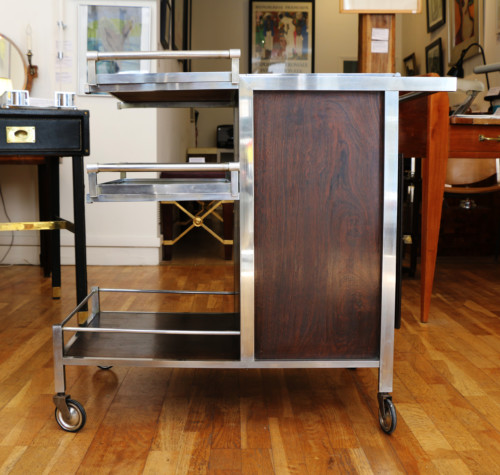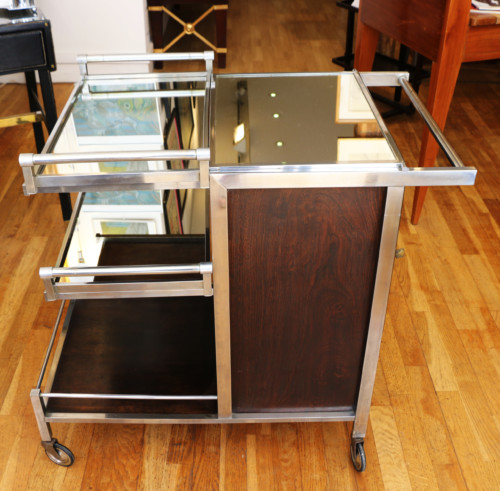Shelves by Emile Guillot, circa 1930. Shelves with three levels and three glass on chromium tubular frame.
-
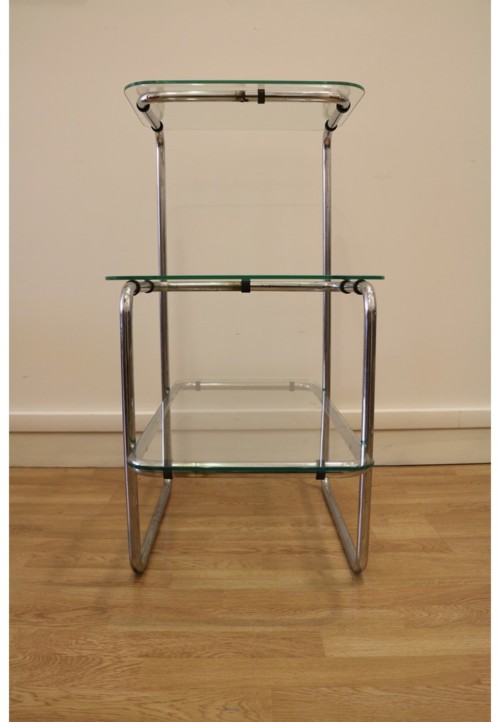
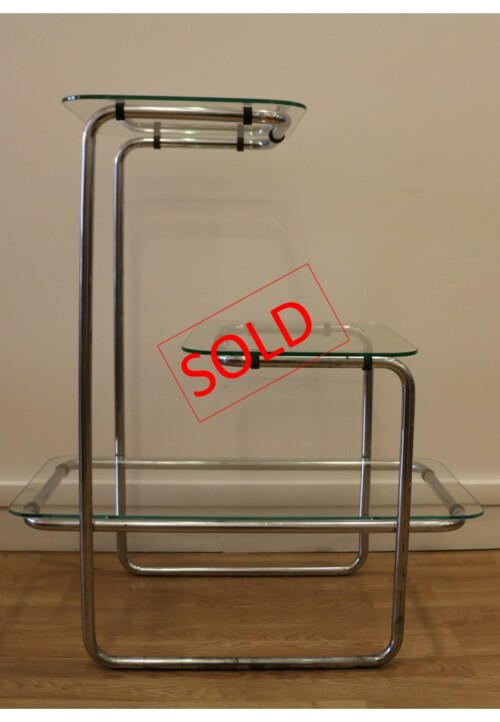 Emile GUILLOT Etagères à trois niveaux Modèle B136 Trois plateaux de verre sur châssis tubulaire chromé. Vers 1930 H : 86 cm ; L : 74 cm ; P : 45 cm
Emile GUILLOT Etagères à trois niveaux Modèle B136 Trois plateaux de verre sur châssis tubulaire chromé. Vers 1930 H : 86 cm ; L : 74 cm ; P : 45 cm
Shelves by Emile Guillot, circa 1930. Shelves with three levels and three glass on chromium tubular frame.Dimensions :H : 33.86 in. ; W : 29.13 in. ; D : 17.72 in.H : 86 cm ; W : 74 cm ; D : 45 cm -
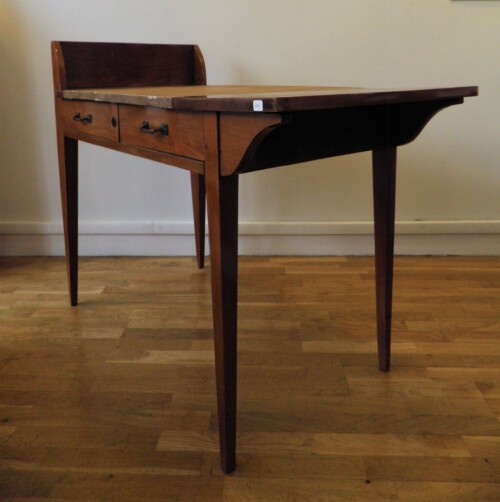
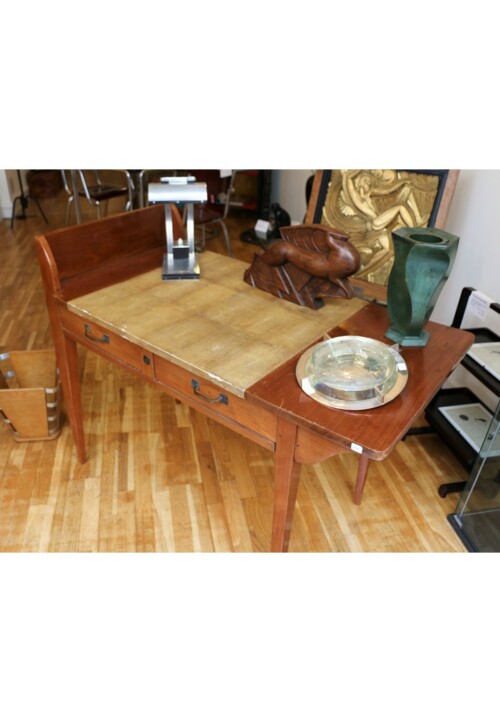 Eugène PRINTZ (1889-1948) Elégant bureau, dessiné par Printz pour la fameuse Cité Universitaire Internationale de Paris, de forme asymétrique, en acajou verni, ouvrant en façade par deux tiroirs. Les poignées sont en métal patiné et les plateau est recouvert d'un revêtement imitant le galuchat. Le bureau est dans son état original, et n'a jamais été restauré. La clef des tiroirs est manquante. Dans notre galerie se trouve aussi une étagère Printz destinée à la même résidence. 1930's H : 91 cm ; L : 113 cm ; P : 55 cm Pour plus d'informations sur le créateur, cliquer sur le nom : Eugène PRINTZ
Eugène PRINTZ (1889-1948) Elégant bureau, dessiné par Printz pour la fameuse Cité Universitaire Internationale de Paris, de forme asymétrique, en acajou verni, ouvrant en façade par deux tiroirs. Les poignées sont en métal patiné et les plateau est recouvert d'un revêtement imitant le galuchat. Le bureau est dans son état original, et n'a jamais été restauré. La clef des tiroirs est manquante. Dans notre galerie se trouve aussi une étagère Printz destinée à la même résidence. 1930's H : 91 cm ; L : 113 cm ; P : 55 cm Pour plus d'informations sur le créateur, cliquer sur le nom : Eugène PRINTZ
Art Déco wooden desk, by Eugène Printz. This asymmetric desk was designed by Eugène Printz (1889-1948) for the famous Cité Universitaire Internationale de Paris (a unique place where multiple residences - one per country - for international students were developped in the 1930's). It is made of varnished mahogany, has 2 drawers with patinated metal handles and is partly covered with canvas with a shagreen pattern. It is in its original condition and has not been restored. The drawer key is missing. The gallery has also in stock a matching book shelf which was also designed by Printz for the same residence. Dimensions : H : 35.83 in. ; W : 44.49 in. ; D : 21.65 in. H : 91 cm ; W : 113 cm ; D : 55 cm For more information : Eugène PRINTZ -
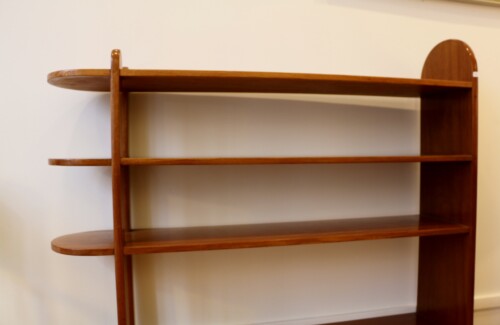
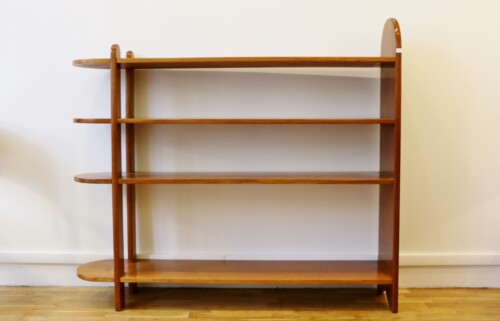 Eugène PRINTZ (1889-1948) Étagère bibliothèque en acajou de 1932, pour la Cité Universitaire de Paris destinée aux chambres d'étudiants de la Maison des Provinces de France. Quatre étagères rectangulaires se terminant en demi-lune H : 119,5 cm ; L : 135 cm ; P : 30 cm Pour plus d'informations sur le créateur, cliquer sur le nom : Eugène PRINTZ
Eugène PRINTZ (1889-1948) Étagère bibliothèque en acajou de 1932, pour la Cité Universitaire de Paris destinée aux chambres d'étudiants de la Maison des Provinces de France. Quatre étagères rectangulaires se terminant en demi-lune H : 119,5 cm ; L : 135 cm ; P : 30 cm Pour plus d'informations sur le créateur, cliquer sur le nom : Eugène PRINTZ
An Art Deco Mahogany Shelf or Bookcase by Eugène Printz, 1932.Light mahogany shelves bookcase with four shelves.
One side of each shelf has an arc of a circle shape. 1932 iconic model from Eugène Printz.
Dimensions :For more information : Eugène PRINTZH : 47.05 in. ; W : 53.15 in. ; D : 11.81 in.H : 119.5 cm ; W : 135 cm ; D : 30 cm -
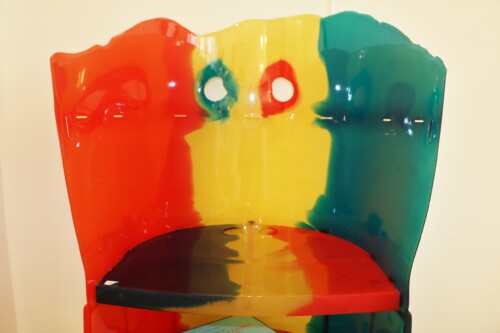
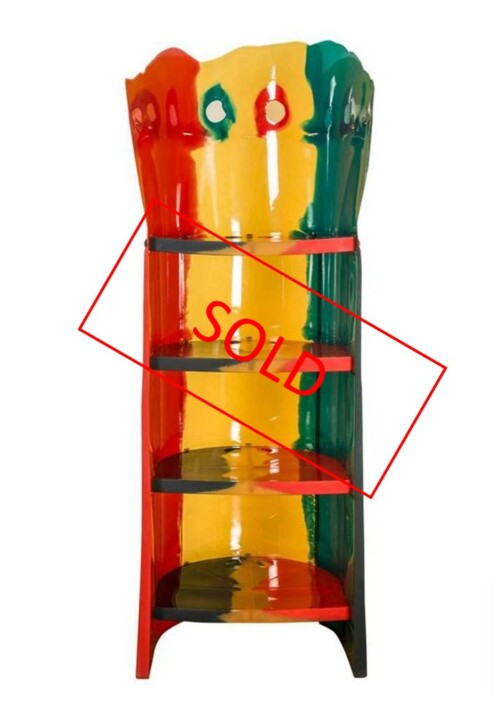
Gaetano PESCE (1939- )
Bibliothèque de la série "Nobody's perfect" en résine translucide et teintée
Quatre étagères ajustables sur cinq positions
Exposition consacrée à la série "Nobody's perfect" au Musée des Arts Décoratifs de décembre 2002 à février 2003
Zerodesigno, 2003 (Gaetano Pesce collabore avec Zerodesigno depuis 2001)
H : 167 cm ; L : 44 cm ; P : 61 cm
Pour plus d'informations sur le créateur, cliquer sur le nom : Gaetano PESCE
"Nobody's Perfect" Bookcase by Gaetano Pesce, Italy, 2003.
Library or bookcase of the Nobody's Perfect series in resin by Gaetano Pesce. Edited by Zerodesigno, 2003. Four adjustable shelves with five positions. The use of colored resin blends makes each bookcase unique.
Rear openings on each back shelf and in the back of the bookcase allows the passage of electric wires.
Dimensions :H : 65.75 in. ; W : 17.32 in. ; D : 24.02 in.H : 167 cm ; W : 44 cm ; D : 61 cmFor more information : Gaetano PESCE
-
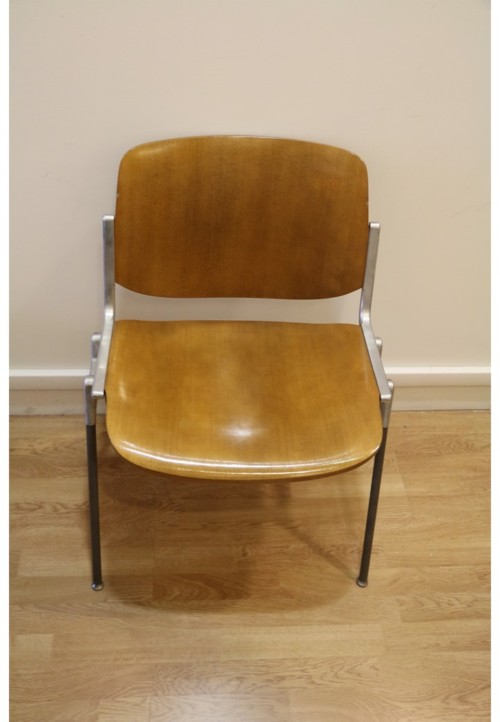
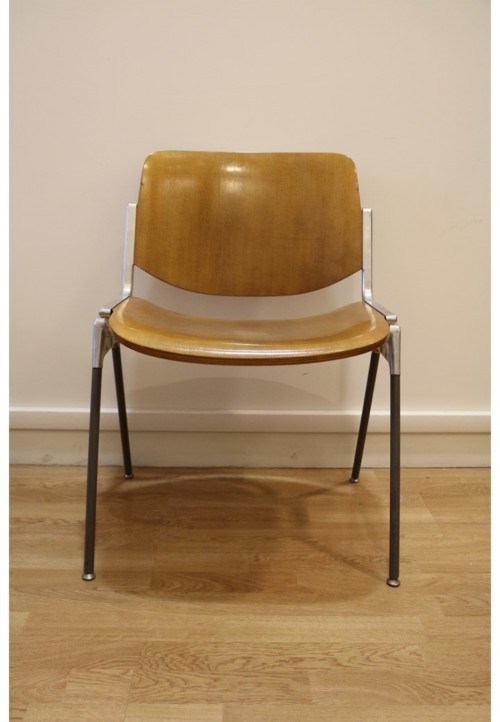 Giancarlo PIRETTI (1940-…) Edition Castelli. Suite de 6 chaises, modèle 106 dessiné en 1967. Assise et dossier en contreplaqué moulé, piètement quadripode tubulaire, gainé avec sabots. Plus édité. Couleur miel clair H : 77 cm ; H d'assise : 48 cm ; L : 56 cm ; P : 48 cm Pour plus d’informations sur le créateur, cliquer sur le nom : Giancarlo PIRETTI
Giancarlo PIRETTI (1940-…) Edition Castelli. Suite de 6 chaises, modèle 106 dessiné en 1967. Assise et dossier en contreplaqué moulé, piètement quadripode tubulaire, gainé avec sabots. Plus édité. Couleur miel clair H : 77 cm ; H d'assise : 48 cm ; L : 56 cm ; P : 48 cm Pour plus d’informations sur le créateur, cliquer sur le nom : Giancarlo PIRETTI
Set of Six Mid-Century Modern Chairs by Giancarlo Piretti, Italy, 1970s. Set of six chairs by Giancarlo Piretti, Model Nr 106 designed in 1967, Italy, Castelli edition. This model is no longer manufactured. Chair back and chair seat made of thermoformed/molded plywood. Veneer has been restored, Very nice light honey color. Legs and frame made of steel and aluminium. These chairs are very comfortable and can be stacked. Another set of six identical chairs is available with a slightly darker veneer. Measures: H 77 cm; Seating H 48 cm; L 56 cm; P 48 cm. For more informations : Giancarlo PIRETTI -
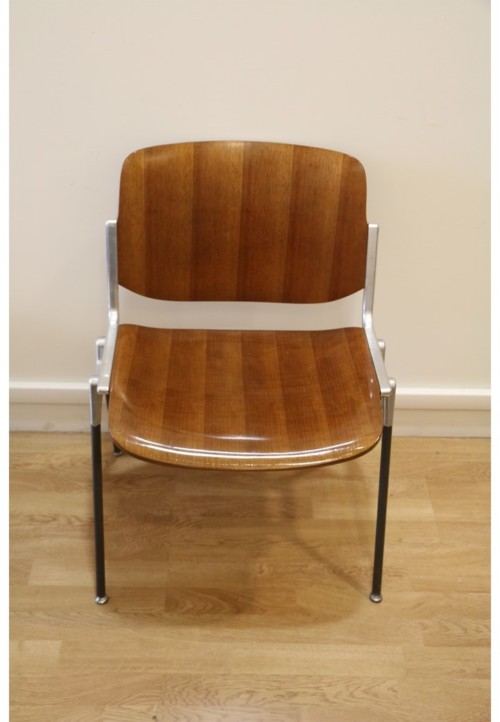
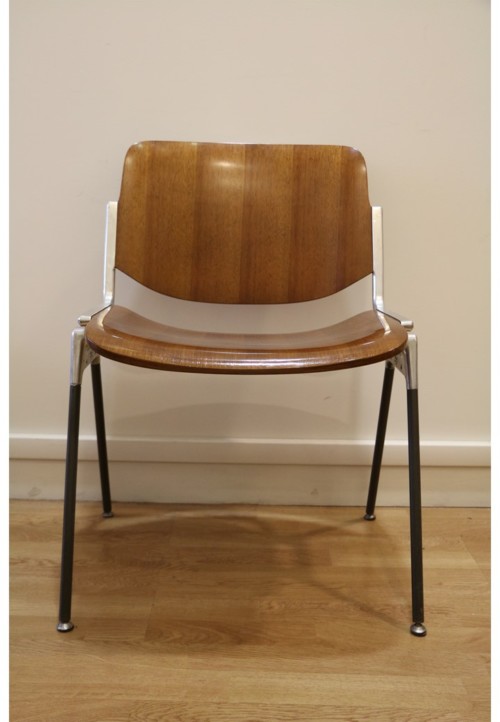 Giancarlo PIRETTI (1940-…) Edition Castelli. Suite de 6 chaises, modèle 106 dessiné en 1967. Assise et dossier en contreplaqué moulé, piètement quadripode tubulaire, gainé avec sabots. Plus édité. Couleur miel foncé H : 77 cm ; H d'assise : 48 cm ; L : 56 cm ; P : 48 cm Pour plus d’informations sur le créateur, cliquer sur le nom : Giancarlo PIRETTI
Giancarlo PIRETTI (1940-…) Edition Castelli. Suite de 6 chaises, modèle 106 dessiné en 1967. Assise et dossier en contreplaqué moulé, piètement quadripode tubulaire, gainé avec sabots. Plus édité. Couleur miel foncé H : 77 cm ; H d'assise : 48 cm ; L : 56 cm ; P : 48 cm Pour plus d’informations sur le créateur, cliquer sur le nom : Giancarlo PIRETTI
Set of Six Mid-Century Modern Chairs by Giancarlo Piretti, Italy, 1970s. Set of six chairs by Giancarlo Piretti, Model Nr 106 designed in 1967, Italy, Castelli edition. This model is no longer manufactured. Chair back and chair seat made of thermoformed/molded plywood. Veneer has been restored, Very nice light honey color. Legs and frame made of steel and aluminium. These chairs are very comfortable and can be stacked. Another set of six identical chairs is available with a slightly lighter veneer. Measures: H 77 cm; Seating H 48 cm; L 56 cm; P 48 cm. For more informations : Giancarlo PIRETTI -
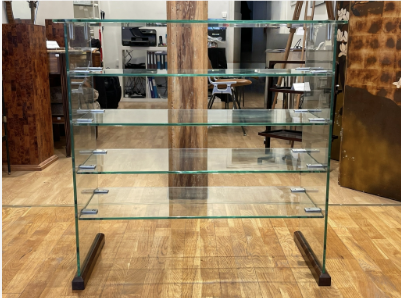
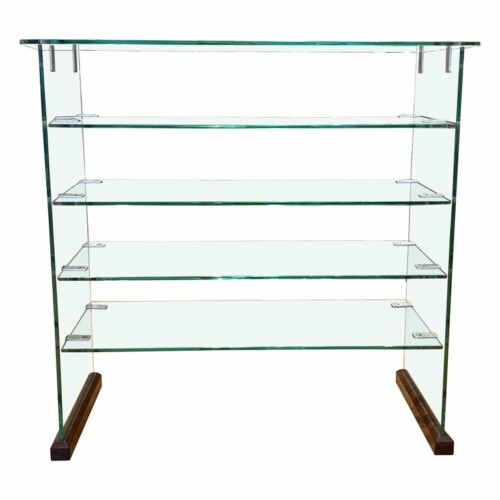 GIO PONTI, Etagère en laiton et verre, Circa 1939 Elégante étagère de laiton et de verre, comportant cinq étagères soutenues de bois maintenues par deux lames de verres aux extrémités, le tout solidement relié et fixé par des vis en laiton. Le verre est engravé « Vitrex » Réalisé à l’origine pour les bureaux de la société Ventrocoke à Milan Gio Ponti est diplômé de l’Ecole Polytechnique de Milan, et ouvre en 1921 son cabinet d’architecture. Il est nommé directeur artistique de la manufacture de porcelaine Richard-Ginori en 1923. En 1925,il remporte un grand prix à l’Exposition internationale des Arts Décoratifs de Paris. Il collabore également avec les marques Christofle à Paris et Venini à Murano. En parallèle, il crééé galement des séries de meubles Art Deco à des prix accessibles , La Rinascente, pour les grands magasins italiens un choix. S’ajoute à cela sa revue Domus fondée en 1928 dans laquelle il mettra en avant le « made in italy ». Dans les années 1930, il entame la construction des Case Tipiche, à Milan, et des bureaux pour la société Montecatini. En 1940, il se consacre au Palazzo del Bo de l’université de Padoue. Pour finir de 1950 à 1960, Gio Ponti sera surtout connu pour son architecture qu’il déployera à travers le monde Dimensions : H : 84 cm L : 88 cm P : 37 cm
GIO PONTI, Etagère en laiton et verre, Circa 1939 Elégante étagère de laiton et de verre, comportant cinq étagères soutenues de bois maintenues par deux lames de verres aux extrémités, le tout solidement relié et fixé par des vis en laiton. Le verre est engravé « Vitrex » Réalisé à l’origine pour les bureaux de la société Ventrocoke à Milan Gio Ponti est diplômé de l’Ecole Polytechnique de Milan, et ouvre en 1921 son cabinet d’architecture. Il est nommé directeur artistique de la manufacture de porcelaine Richard-Ginori en 1923. En 1925,il remporte un grand prix à l’Exposition internationale des Arts Décoratifs de Paris. Il collabore également avec les marques Christofle à Paris et Venini à Murano. En parallèle, il crééé galement des séries de meubles Art Deco à des prix accessibles , La Rinascente, pour les grands magasins italiens un choix. S’ajoute à cela sa revue Domus fondée en 1928 dans laquelle il mettra en avant le « made in italy ». Dans les années 1930, il entame la construction des Case Tipiche, à Milan, et des bureaux pour la société Montecatini. En 1940, il se consacre au Palazzo del Bo de l’université de Padoue. Pour finir de 1950 à 1960, Gio Ponti sera surtout connu pour son architecture qu’il déployera à travers le monde Dimensions : H : 84 cm L : 88 cm P : 37 cm
GIO PONTI, Brass and glass shelf, Circa 1939 Elegant brass and glass shelf, featuring five supported wooden shelves held by two glass blades at the ends, all securely connected and fixed by brass screws. The glass is engraved «Vitrex» Originally designed for the Ventrocoke offices in Milan Gio Ponti graduated from the Polytechnic of Milan, and opened his architectural practice in 1921. He was appointed artistic director of the Richard-Ginori porcelain factory in 1923. In 1925, he won a grand prize at the International Exhibition of Decorative Arts in Paris. He also collaborates with the brands Christofle in Paris and Venini in Murano. In parallel, he also created series of Art Deco furniture at affordable prices , La Rinascente, for Italian department stores a choice. In addition to this, his magazine Domus, founded in 1928, will highlight the «made in italy». In the 1930s, he began the construction of the Case Tipiche in Milan and offices for the company Montecatini. In 1940 he dedicated himself to the Palazzo del Bo of the University of Padua. To finish from 1950 to 1960, Gio Ponti will be best known for his architecture that he will deploy around the world Dimensions: H: 33.1inches W: 34.5inches D: 14.5inches -
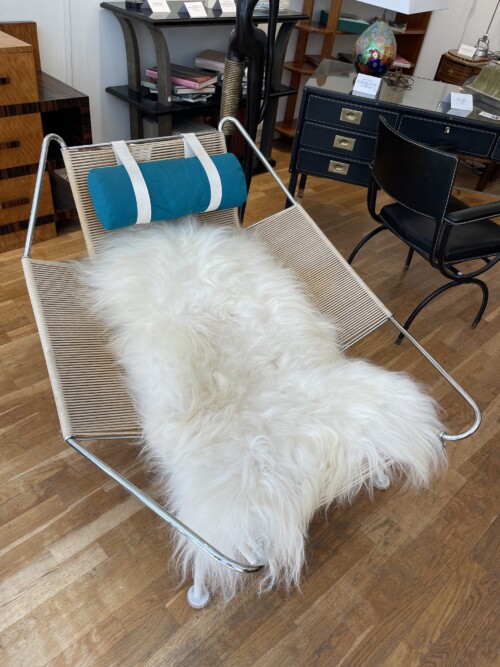
 Iconique fauteuil Flag Halyard par Hans Wegner (1914-2007), édition par Getama, 1950. Ce modèle est connu comme le Model 225 ou la Flag Halyard Chair et présente son originalité par ses matériaux, les créations de Wegner étant habituellement faites de bois. La légende dit que Wegner aurait reçu le challenge de créer un fauteuil en métal et la Flag Halyard Chair serait la réponse à celui-ci. On raconte aussi que l'idée du design lui est venue sur une plage d'Arhus (Danemark) : la forme de la chaise est calquée sur la forme d'une assise creusée dans le sable de la plage pour être parfaitement adaptée au corps humain. Le nom Flag Halyard vient du type de corde utilisée pour la chaise et qui est extrêmement solide et résistante. La chaise est composée d'un acier inoxydable laqué blanc, d'une corde, d'un coussin et d'une peau de mouton (moderne). Il s'agit de l'une des premières éditions de 1950 du fabricant d'origine Getama. Elle porte les signes typiques d'une édition Getama : chaise chaussures en bois, numérotée 384 sur la structure en acier. Elle a été fabriquée à la main avec 240 mètres de corde et peu ont été produites dans le cadre de la première édition. La chaise est en bon état, des réparations anciennes ont été faites sur les cordes : deux sont visibles, quatre sont en dessous de l'assise. Pour plus d'informations sur Wegner, cliquez ici Iconic chair by Hans Wegner (1914 - 2007). This model is known as Model 225 or Flag Halyard Chair. It is very original in Wegner creations as he used to work mostly with wood. The legend says that he was challenged to design a metal chair and here is his answer. It is also said that the idea of the design came to him on a beach in Arhus (Denmark): the shape of the chair is modeled on the form of a seat carved out in the sand beach to be perfectly adapted to the human body. The name Flag Halyard comes from the type of rope used for the chair and which is extremely strong and resistant. The chair comprises a stainless steel lacquered in white, rope, a cushion and a sheep skin (modern). This is one of the early edition from 1950 by the original manufacturer Getama. It bears the typical signs of a Getama edition : chair shoes in wood, numbered 384 on the steel frame. It was made by hand with 240 meters of rope and few were produced as part of the early edition. The chair is in good condition, ancient repairs have been made on the ropes : two are visible, four are below the seat. For more information about Wegner, click here
Iconique fauteuil Flag Halyard par Hans Wegner (1914-2007), édition par Getama, 1950. Ce modèle est connu comme le Model 225 ou la Flag Halyard Chair et présente son originalité par ses matériaux, les créations de Wegner étant habituellement faites de bois. La légende dit que Wegner aurait reçu le challenge de créer un fauteuil en métal et la Flag Halyard Chair serait la réponse à celui-ci. On raconte aussi que l'idée du design lui est venue sur une plage d'Arhus (Danemark) : la forme de la chaise est calquée sur la forme d'une assise creusée dans le sable de la plage pour être parfaitement adaptée au corps humain. Le nom Flag Halyard vient du type de corde utilisée pour la chaise et qui est extrêmement solide et résistante. La chaise est composée d'un acier inoxydable laqué blanc, d'une corde, d'un coussin et d'une peau de mouton (moderne). Il s'agit de l'une des premières éditions de 1950 du fabricant d'origine Getama. Elle porte les signes typiques d'une édition Getama : chaise chaussures en bois, numérotée 384 sur la structure en acier. Elle a été fabriquée à la main avec 240 mètres de corde et peu ont été produites dans le cadre de la première édition. La chaise est en bon état, des réparations anciennes ont été faites sur les cordes : deux sont visibles, quatre sont en dessous de l'assise. Pour plus d'informations sur Wegner, cliquez ici Iconic chair by Hans Wegner (1914 - 2007). This model is known as Model 225 or Flag Halyard Chair. It is very original in Wegner creations as he used to work mostly with wood. The legend says that he was challenged to design a metal chair and here is his answer. It is also said that the idea of the design came to him on a beach in Arhus (Denmark): the shape of the chair is modeled on the form of a seat carved out in the sand beach to be perfectly adapted to the human body. The name Flag Halyard comes from the type of rope used for the chair and which is extremely strong and resistant. The chair comprises a stainless steel lacquered in white, rope, a cushion and a sheep skin (modern). This is one of the early edition from 1950 by the original manufacturer Getama. It bears the typical signs of a Getama edition : chair shoes in wood, numbered 384 on the steel frame. It was made by hand with 240 meters of rope and few were produced as part of the early edition. The chair is in good condition, ancient repairs have been made on the ropes : two are visible, four are below the seat. For more information about Wegner, click here -
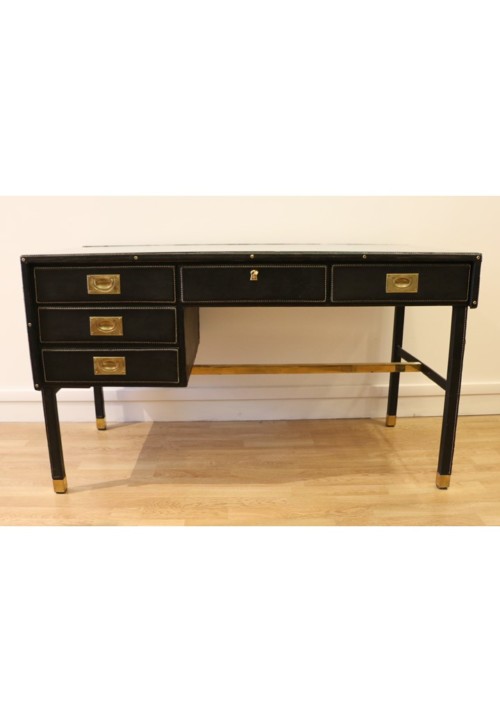
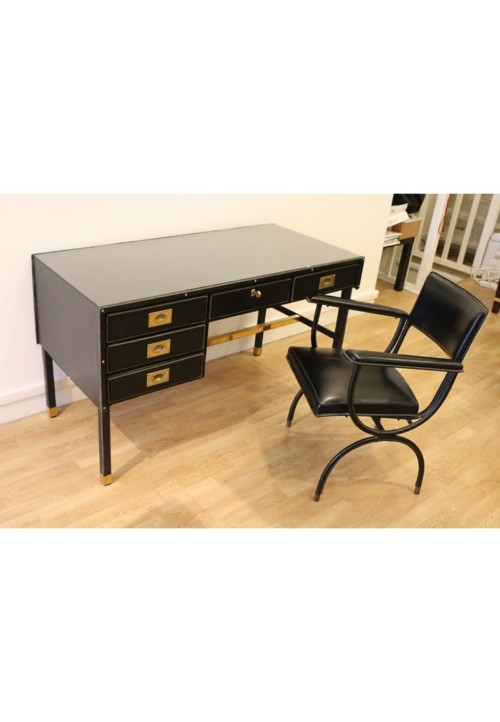 Jacques ADNET (1900-1984) Bureau et son fauteuil Recouverts skaï et cuir piqué sellier. Poignées bateau et sabots en laiton Années 50 H : 77,5 cm ; L : 131 cm ; P : 61,5 cm Pour plus d’informations sur le créateur, cliquer sur le nom : Jacques ADNET
Jacques ADNET (1900-1984) Bureau et son fauteuil Recouverts skaï et cuir piqué sellier. Poignées bateau et sabots en laiton Années 50 H : 77,5 cm ; L : 131 cm ; P : 61,5 cm Pour plus d’informations sur le créateur, cliquer sur le nom : Jacques ADNET
Desk and armchair Covered in skai and saddle-stitched leather. Boat handles and brass shoes. 1950's H: 77.5 cm; W: 131 cm; D: 61.5 cm For more informations : : Jacques ADNET -
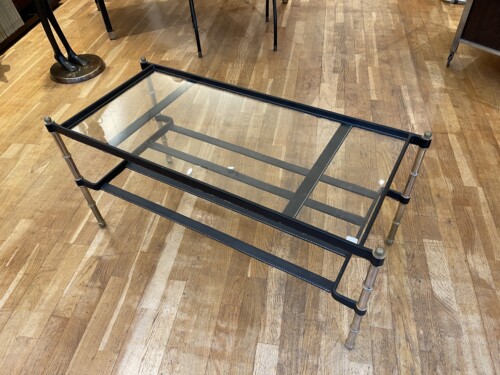
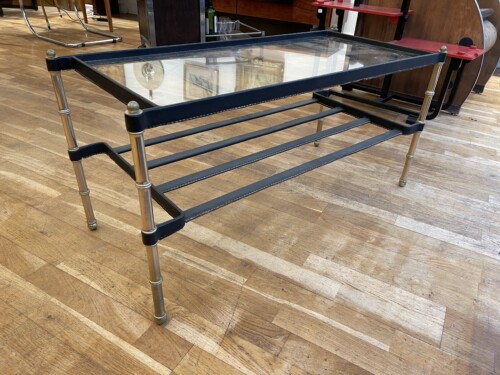 Vers 1950 Table basse du célèbre designer français Jacques Adnet (1900-1984). Il s'agit d'une création typique d'Adnet du début des années 1950 utilisant la technique du "Piqué Sellier" (technique du "cuir cousu") qu'il a inventée et adaptée aux meubles, les recouvrant de cuir. La table a une structure en laiton doré avec des pieds imitant le bambou et partiellement recouverts de cuir piqué. Plateau en verre (probablement remplacé). Très bon état. H : 47 cm ; L : 95 cm ; P : 42 cm Pour plus d’informations sur le créateur, cliquer sur le nom : Jacques ADNET
Vers 1950 Table basse du célèbre designer français Jacques Adnet (1900-1984). Il s'agit d'une création typique d'Adnet du début des années 1950 utilisant la technique du "Piqué Sellier" (technique du "cuir cousu") qu'il a inventée et adaptée aux meubles, les recouvrant de cuir. La table a une structure en laiton doré avec des pieds imitant le bambou et partiellement recouverts de cuir piqué. Plateau en verre (probablement remplacé). Très bon état. H : 47 cm ; L : 95 cm ; P : 42 cm Pour plus d’informations sur le créateur, cliquer sur le nom : Jacques ADNET
Coffee table Circa 1950 Coffee table by famous French designer Jacques Adnet (1900-1984). It is a typical creation of Adnet from the early 1950's using 'Piqué Sellier" technique ("stitched leather" technique) he invented and adapted to furniture, covering them with leather. The table has a gilded brass structure with legs imitating bamboo and partially covered with stitched leather. Glass top (probably replaced). Very good condition. H : 47 cm ; W : 95 cm ; D : 42 cm For more informations : Jacques ADNET -
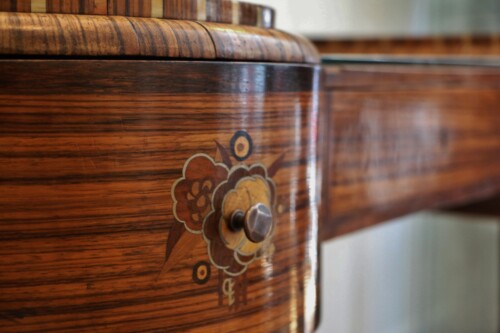
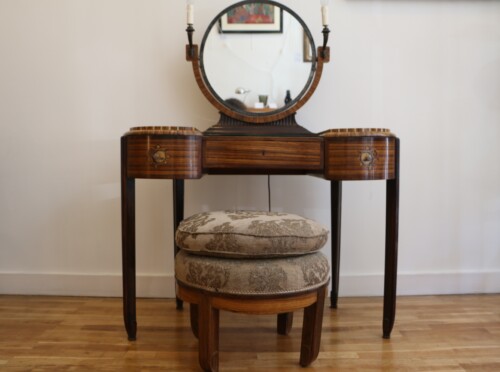 Coiffeuse en placage de Coromandel et palissandre Piétement cannelé se terminant par un enroulement. Trois tiroirs en ceinture dont deux ornés d'une petite marqueterie à décor floral. Miroir circulaire en métal argenté. Un petit tabouret est joint à la coiffeuse. H : 48 cm ; Diamètre : 39 cm. Il est recouvert d'un tissu ancien avec un coussin brun Estampillée sur la serrure "Krieger" Période Art Déco, vers 1925 H : 133 cm ; L : 101 cm ; P : 54 cm Pour plus d'informations sur la fabrique, cliquer sur le nom : KRIEGER
Coiffeuse en placage de Coromandel et palissandre Piétement cannelé se terminant par un enroulement. Trois tiroirs en ceinture dont deux ornés d'une petite marqueterie à décor floral. Miroir circulaire en métal argenté. Un petit tabouret est joint à la coiffeuse. H : 48 cm ; Diamètre : 39 cm. Il est recouvert d'un tissu ancien avec un coussin brun Estampillée sur la serrure "Krieger" Période Art Déco, vers 1925 H : 133 cm ; L : 101 cm ; P : 54 cm Pour plus d'informations sur la fabrique, cliquer sur le nom : KRIEGER
Art Deco dressing table with stool by Krieger, circa 1925.Rosewood dressing table with arrow-tip legs and wound motif feet. Three side drawers, two drawers decorated with floral adornment marquetry (made of mixed exotic woods, metal and ivoirine). Silver plated circular mirror. Two small lighted bronze torcheres. The round stool is covered with an old grey fabric and has a same color cushion.
Krieger stamp on the lock. House Krieger was a famous cabinetmaker in the 1920s-1930s established 74 Faubourg Saint-Antoine in Paris (12th arrondissement). Wired for European use.
Dimensions :For more information : KRIEGERH : 52.36 in. ; W : 39.76 in. ; D : 21.26 in.H : 133 cm ; W : 101 cm ; D : 54 cm
